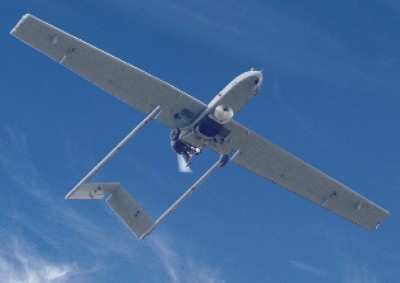Mon, Nov 07, 2011
Dedicated Asset Allows UAS Test Directorate To Assess New
Technologies, Support New Missions For Marine Corps
Naval Air Warfare Center Aircraft Division, UAS Test
Directorate, has established and demonstrated a dedicated Shadow
Tactical Unmanned Aircraft System for test and evaluation
purposes.
Shadow UAS File Photo

Having completed its inaugural flight from the Webster Field
Annex in Maryland, just miles from Naval Air Station Patuxent
River, the system will be used to support U.S. Navy and Marine
Corps Small Tactical UAS Program Office (PMA-263) test and
evaluation initiatives, including the Wide Focal Plane Array Camera
(WFPAC) payload development effort. The WFPAC payload would enable
Shadow system users to conduct persistent surveillance over wider
search areas. Apart from WFPAC payload testing, the Shadow test and
evaluation system also is slated to be used by PMA-263 in testing
other new payloads to support additional new mission profiles.
“Our Marine Corps customers have utilized Shadow systems
in operational areas including Afghanistan and Iraq for many years
now, and they continue to demonstrate new and innovative
operational concepts for them,” says Senior Vice President
& General Manager Steven Reid of AAI UAS. “This dedicated
test and evaluation system is an excellent way for them to continue
this innovation by validating new missions for their Shadow
assets.”
Shadow UAS File Photo

AAI’s longstanding relationship with PMA-263 started in
the 1980s, upon the Navy’s selection of the Pioneer Unmanned
Aerial Vehicle after a competitive fly-off. The RQ-2 Pioneer
systems were workhorses for the Navy, with a storied history
including Iraqi troops offering surrender to an aircraft during the
Gulf War in the early 1990s. The last Pioneer systems were retired
from service as recently as 2007.
“Along with many of our team members, I have fond memories
of working at the same location many years ago, testing the Pioneer
unmanned aircraft assets that served the Navy so well until the
fleet’s retirement,” says Reid. “It is tremendous
to be back on-site with this group again to evaluate
state-of-the-art UAS capabilities with the Shadow
system.”
More News
From 2023 (YouTube Version): Legacy of a Titan Robert (Bob) Anderson Hoover was a fighter pilot, test pilot, flight instructor, and air show superstar. More so, Bob Hoover was an i>[...]
Get The Latest in Aviation News NOW on Instagram Are you on Instagram yet? It's been around for a few years, quietly picking up traction mostly thanks to everybody's new obsession >[...]
Aero Linx: B-52H Stratofortress The B-52H Stratofortress is a long-range, heavy bomber that can perform a variety of missions. The bomber is capable of flying at high subsonic spee>[...]
Altimeter Setting The barometric pressure reading used to adjust a pressure altimeter for variations in existing atmospheric pressure or to the standard altimeter setting (29.92).>[...]
"Knowing that we play an active part in bettering people's lives is extremely rewarding. My team and I are very thankful for the opportunity to be here and to help in any way we ca>[...]
 Classic Aero-TV: Remembering Bob Hoover
Classic Aero-TV: Remembering Bob Hoover ANN FAQ: Follow Us On Instagram!
ANN FAQ: Follow Us On Instagram! ANN's Daily Aero-Linx (05.15.24)
ANN's Daily Aero-Linx (05.15.24) ANN's Daily Aero-Term (05.15.24):Altimeter Setting
ANN's Daily Aero-Term (05.15.24):Altimeter Setting Aero-News: Quote of the Day (05.16.24)
Aero-News: Quote of the Day (05.16.24)




